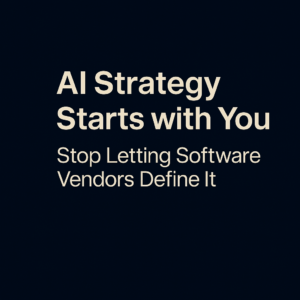Discipline encompasses a wide variety of strategies and work streams that one can employ to implement change within an organization. However, it can be simplified. Today, I would like to discuss the five most crucial steps to ensure the success of your change initiatives.

One of our primary service offerings is change management. We assist clients undergoing digital and business transformations by supporting their change management initiatives. Our goal is to ensure these change initiatives are managed effectively and achieve success. We have observed that many organizations, as well as individuals, often find the concept of change management daunting. The plethora of tactics available and the various training courses can lead to confusion. To address this, I aim to simplify change management by presenting five essential steps. These steps are crucial in ensuring the success of your change initiatives.
Table of Contents
ToggleChange Readiness Assessment
The initial step in implementing a change strategy is to conduct a Change Readiness Assessment. Many organizations assume they are prepared for change based solely on their acknowledgment of the need for transformation. However, the purpose of a Change Readiness Assessment isn’t just to determine if an organization is prepared, but rather to gauge the extent of its readiness. Moreover, it aids in predicting potential areas of resistance during a digital transformation.
Change within an organization involves numerous elements, such as process improvements, organizational restructuring, and the introduction of new tools and systems. These factors, combined with the existing organizational culture, past experiences with change, leadership styles, and other unique characteristics, can inadvertently lead to resistance. The objective of the Change Readiness Assessment is not to determine if resistance will occur but to proactively address its potential origins. It’s more about discerning how individuals will resist, evaluating the intensity of this resistance, and understanding its root causes. Even the most well-intentioned employees may resist change, not out of malice or intent to hinder progress, but because imposed changes can evoke feelings of fear, uncertainty, and doubt in their roles.
When executing Change Readiness Assessments, we typically employ a dual-faceted approach. First, we utilize an online anonymous tool to gather quantitative data regarding the organization’s culture, leadership, collaboration, and communication styles. This aids in pinpointing potential resistance areas. The second facet involves qualitative focus groups, diving deeper into the organization’s cultural nuances. By merging both the quantitative and qualitative datasets, we can better anticipate and counteract potential resistance sources.
In essence, the Change Readiness Assessment is paramount, perhaps the foremost step in a change management initiative. It equips organizations with a comprehensive understanding of their existing landscape, enabling the formulation of a change strategy that addresses and aligns with the findings of the assessment.
Executive Alignment
Successful digital transformation is contingent upon the alignment of both executives and the overall organization. When referring to “alignment,” it is imperative for an organization to share a unified vision, direction, and understanding of its future trajectory. Inevitably, as an organization grows, incorporates new personnel, and integrates varying personalities, some degree of misalignment will occur. This is a natural consequence, especially for larger and more intricate organizations. Although this misalignment is often unavoidable, recognizing and addressing these discrepancies is crucial.
Consider a recent client case study as an illustration. This client expanded rapidly through mergers and acquisitions, incorporating over 40 different companies in less than five years. They sought our expertise to develop and implement a digital strategy to unify business processes, establish a shared services model, and assimilate these 40 entities into a cohesive global enterprise. While this objective appeared clear-cut, disagreements arose among executives regarding the specifics of this unification. A consensus on what it truly meant to operate as a single entity was elusive. Such disagreements hindered the transformation’s progress. It’s evident that if the leadership lacks clarity and consensus on the overarching vision and strategy, the broader organization will face similar challenges of misalignment.
It’s essential to invest time in ensuring that executives reach a consensus. For a more in-depth exploration of executive alignment and our approach to it, I recommend viewing a detailed video on our YouTube channel. This resource offers a comprehensive framework that can be tailored to your organization’s alignment needs.

Change Impact Assessment
The third pivotal step in a change strategy is conducting a Change Impact Assessment. This assessment examines the organization’s current state, its desired future state following the change initiative, and identifies the disparities between the two. This analysis should be undertaken not only at a holistic organizational level but also at the departmental, business unit, and, where applicable, individual levels.
For an employee navigating organizational change, it’s essential to understand the direct implications on their role. While an individual may appreciate the broader organizational objectives, their full commitment to the change is contingent on understanding and becoming comfortable with its specific impact on their position. The Change Impact Assessment aims to determine, in detail, how changes will resonate throughout the organization, facilitating early engagement and alignment with affected personnel.
One advantage of a Change Impact Assessment is that it surfaces potential concerns or “change shock” moments earlier in the transformation process. Instead of waiting for formal training sessions or the later stages of the initiative to introduce significant role modifications, these changes are preemptively addressed. Early assessment enables proactive communication and preparatory sessions to guide individuals through impending changes in roles and responsibilities.
It’s essential to anticipate and address inevitable reactions to change. Employees might have concerns, for instance, about losing familiar tools like specific spreadsheets, undergoing substantial job modifications, or having certain tasks automated by AI. Clearly delineating these impacts is paramount.
However, a cautionary note is essential: many organizations and their project teams sometimes bypass this step. Engrossed in future-state designs or pressured by software vendors to expedite new technology deployments, they may neglect the human aspect of change. Yet, the Change Impact Assessment remains indispensable, forming the bedrock for subsequent change management endeavors.
Organizational Design
Disruptive technology has the potential to significantly alter organizational dynamics. While technology can indeed revolutionize businesses, it also has a profound human impact, often more pronounced than in previous eras. As jobs evolve and methodologies shift due to technological advances, it’s imperative to address these changes in a change strategy.
Take, for instance, the introduction of artificial intelligence tools intended to automate a substantial portion of an individual’s job. If an employee learns that 30-40% of their tasks will be automated, they might naturally harbor concerns. Will their job become redundant? Might they be replaced? Will their value diminish in the organization’s eyes? Such uncertainties underscore the critical human psychology aspects that must be addressed during a digital transformation.
It’s not merely about communicating that a fraction of a person’s role will be automated; it’s about providing clarity on the evolving job landscape. This change might entail adjusting reporting structures, altering collaboration methods, or redefining job responsibilities. Thus, organizational design becomes pivotal in change management.
Unfortunately, the emphasis on organizational design is frequently overlooked. Often, there’s a rush to focus on the end goal: implementing new technologies, assuming employees will adapt seamlessly, and quickly training them on these tools. But the true objective behind deploying these technologies is enhancing organizational success, efficiency, and profitability, as well as bolstering team effectiveness.
Merely implementing technology isn’t the panacea. Defining the organizational structure, delineating job roles, and establishing clear responsibilities are crucial. Hence, organizational design must be prioritized, ensuring it is among the key elements in an effective change strategy.

Benefits Realization
A fifth essential step in organizational change management is benefits realization, also known as value realization. This step, while not immediately apparent as relevant to change management, plays a significant role in the process. Benefits realization pertains to how an organization taps into the potential value of the technological and process improvements it undertakes.
Merely introducing new technology does not guarantee the realization of its associated benefits. The true value materializes when the benefits have been effectively managed, aligning with the project’s value optimization goals. This process begins with the creation of a business case. While most organizations understand the importance of a business case—often required to justify the project and determine its ROI—many tend to neglect it post-approval. Instead of letting it be a forgotten document, successful change initiatives use the business case as a tool for ongoing benefit realization and value optimization.
The reality, often challenging for many to confront, is that the expected business value from a new initiative may not be realized as swiftly as anticipated. However, recognizing this early is more productive than ignoring it. By employing benefits realization, organizations can periodically assess the actual business value derived post-implementation, making necessary adjustments. This could involve process enhancements, retraining, or even a different technological deployment approach. This method fosters agility and ensures the best return on the project’s investment.
Additionally, benefits realization serves as a guiding principle during the transformation, facilitating better decision-making, especially in situations involving potential scope expansions or deployments of new technologies. It allows for more ROI-driven decisions that align with the organization’s business value goals and bolsters project governance.
In conclusion, benefits realization is a vital component of a change management strategy. While the aforementioned steps provide a foundational guideline for initiating a change management strategy, they aren’t exhaustive. However, starting with these five steps will offer substantial value, particularly for organizations with constrained resources or time.
I would enjoy brainstorming ideas with you if you are looking to strategize an upcoming transformation or are looking at selecting an ERP system, so please feel free to contact me at eric.kimberling@thirdstage-consulting.com. I am happy to be a sounding board as you continue your digital transformation journey.
Be sure to download the newly released 2024 Digital Transformation Report to garner additional industry insight and project best practices.





